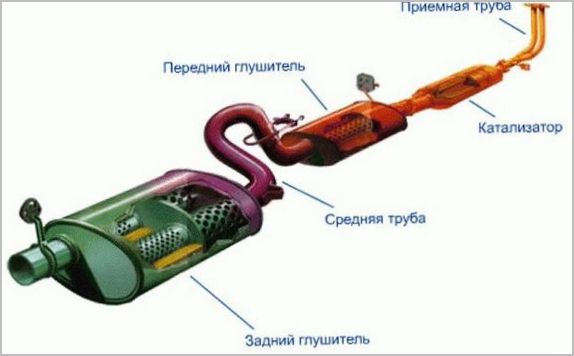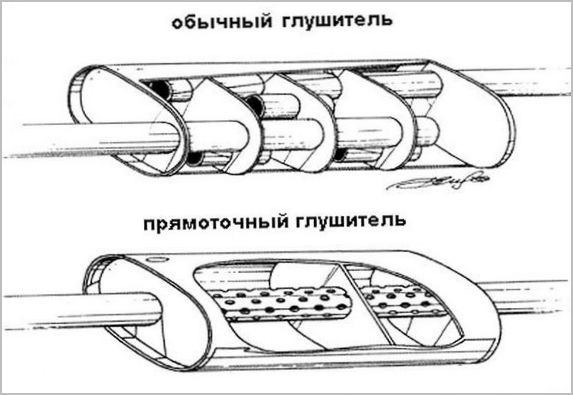
How does a car muffler work, what is the principle of operation based on
Content
The car muffler is designed to reduce exhaust noise in the exhaust system in accordance with international standards. This is a metal case, inside of which partitions and chambers are made, forming channels with complex routes. When exhaust gases pass through this device, sound vibrations of various frequencies are absorbed and converted into heat energy.
The main purpose of the muffler in the exhaust system
In the engine exhaust system, the muffler is installed after the catalytic converter (for petrol vehicles) or the particulate filter (for diesel engines). In most cases there are two:
- Preliminary (silencer-resonator) - designed to sharply suppress noise and stabilize fluctuations in the flow of exhaust gases at the engine outlet. It is installed first, which is why it is often referred to as the "front". One of its main functions is the distribution of exhaust gases in the system.
- Main Silencer - Designed for maximum noise reduction.

In practice, the car muffler device provides the following transformations to reduce exhaust noise:
- Changing the cross section of the exhaust flow. It is carried out due to the presence in the design of chambers of different sections, which allows you to absorb high-frequency noise. The principle of the technology is simple: first, the mobile flow of exhaust gases narrows, which creates a certain sound resistance, and then expands sharply, as a result of which the sound waves are scattered.
- Exhaust redirection. It is carried out by partitions and displacement of the axis of the tubes. By turning the exhaust flow at an angle of 90 degrees or more, the high-frequency noise is damped.
- Change in gas oscillations (interference of sound waves). This is achieved by the presence of perforations in the pipes through which the exhaust passes. This technology allows you to remove noise of different frequencies.
- "Autoabsorption" of sound waves in the Helmholtz resonator.
- Absorption of sound waves. In addition to the chambers and perforations, the muffler body has a sound-absorbing material that isolates the noise.
Types of mufflers and their designs
There are two types of mufflers used in modern cars: resonant and straight-through. Both can be installed together with a resonator (pre-muffler). In some cases, a straight-through design may replace the front muffler.
Resonator design
Structurally, the muffler resonator, which is also called a flame arrester, is a perforated tube located in a sealed housing, divided into several chambers. It consists of the following elements:
- cylindrical body;
- thermal insulation layer;
- blind partition;
- perforated pipe;
- throttle.
Resonant silencer device
Unlike the preliminary, the main resonant muffler is more complex. It consists of several perforated pipes installed in a common body, separated by partitions and located on different axes:
- perforated front tube;
- perforated rear tube;
- inlet pipe;
- front baffle;
- middle partition;
- back partition;
- exhaust pipe;
- oval body.

Thus, in a resonant silencer, various transformations of sound waves of different frequencies are used.
Characteristics of a straight muffler
The main disadvantage of a resonant muffler is the back pressure effect resulting from the redirection of the exhaust gas flow (when colliding with baffles). In this regard, many motorists carry out tuning of the exhaust system by installing a direct muffler.
Structurally, the straight muffler consists of the following components:
- sealed housing;
- exhaust and intake pipe;
- perforated pipe;
- soundproofing material - the most commonly used fiberglass is resistant to high temperatures and has good sound-absorbing properties.
In practice, a straight-through silencer works according to the following principle: a perforated pipe passes through all chambers. Thus, there is no noise suppression by changing the direction and cross section of the gas flow, and noise suppression is achieved only due to interference and absorption.

Due to the free flow of exhaust gases through the forward-flow muffler, the resulting back pressure is very low. However, in practice, this does not allow a significant increase in power (3% - 7%). On the other hand, the sound of the car becomes characteristic of a sports car, since the soundproofing technologies present only suppress high frequencies.
The comfort of the driver, passengers and pedestrians depends on the operation of the muffler. Thus, during long-term operation, the increase in noise can cause serious inconvenience. Today, the installation of a direct-flow muffler in the design of a car moving in an urban area is an administrative offense that threatens with a fine and an order to dismantle the device. This is due to the excess of noise standards established by the standards.
